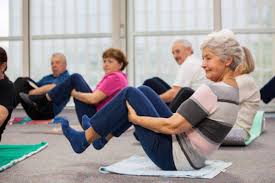
Following our previous blog post on osteoporosis we have a case study of one of our exercise physiology clients. Sarah*, a 63-year-old woman, began her exercise physiology treatment in January 2016 and was initially seeking treatment for low back pain. She had a family history of osteoporosis and was eager to do everything she could do avoid developing it herself. From the start of her exercise physiology treatment Sarah had a goal to progress to a resistance training program to help her maintain her bone mineral density.
When Sarah started her exercise physiology treatment, she had no experience with weight training and was nervous with weighted exercises. To help her alleviate her back pain and to allow her to gain confidence her treatment started with body weight-based exercises such as bodyweight squats, push ups, TRX rows and plank variations. These exercises helped her get used to resistance exercise and began building strength. They helped target multiple muscle groups and provided a good stimulus for bone health.
As Sarah’s back pain resolved and she became stronger and more confident, her treatment progressed to using weights. It started with light dumbbells and kettlebells while performing compound movements such as goblet squats and deadlifts. These exercises are the cornerstone of an effective resistance training program to help prevent and manage osteoporosis. They require the largest muscle groups in the body; the hamstrings, glutes, adductors and quads as well as the muscles around the spine. These large muscles produce large amounts of force and provide stimulus for increasing bone mineral density. They also have the added benefit of using muscles that attach to areas that are particularly prone to osteoporosis; the hip, neck of the femur and spine.
Recently we have introduced some jumping and medicine ball exercises into Sarah’s exercise physiology program to help improve her bone mineral density. It took a number of months to build up to the point where she was confident in trying jumping exercises due to a history of back and knee pain. She is now regularly performing jumping during her weekly partnered exercise physiology sessions. She also performs throwing exercises with medicine balls. Medicine ball exercises provide an impact and power stimulus for the upper body. They are also fun and remind Sarah of her time playing netball when she was younger.
During a recent GP appointment Sarah’s bone mineral density had remained in the low end of the healthy range. She is still eager to prevent it progressing to osteopenia and continues to exercise regularly. She attends a weekly partnered exercise physiology session and also works out twice a week in the gym in her apartment block. Sarah now is looking at increasing the amount of jumping and power exercise she does. This is to both help maintain her bone mineral density as well as to help reduce her risk of a fall as she gets older.
If you have or are at risk of osteoporosis and would like to try an active approach to managing your condition get in contact with us. At Central Performance we have three exercise physiologist who are experienced with treating clients with osteopenia and osteoporosis. We can help to design an exercise program to suit you, your experience with exercises and any other conditions you may also have.
*name has been changed

